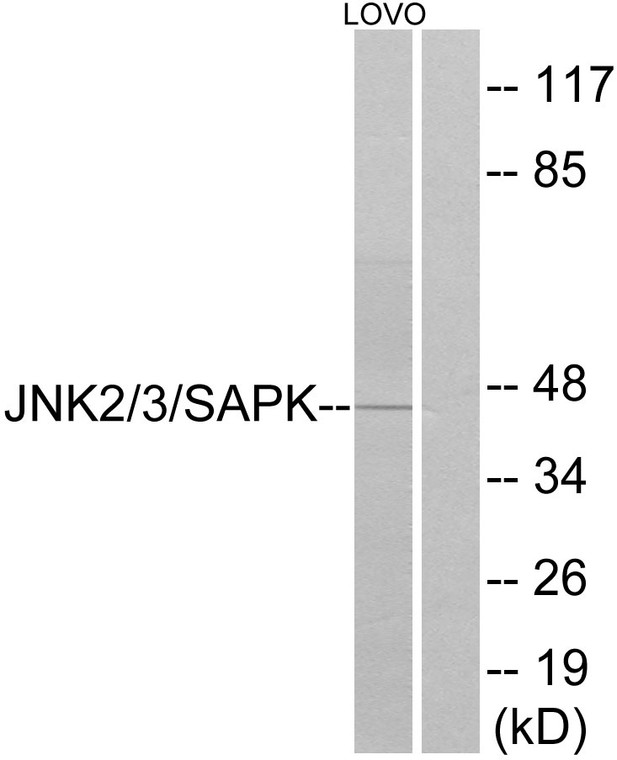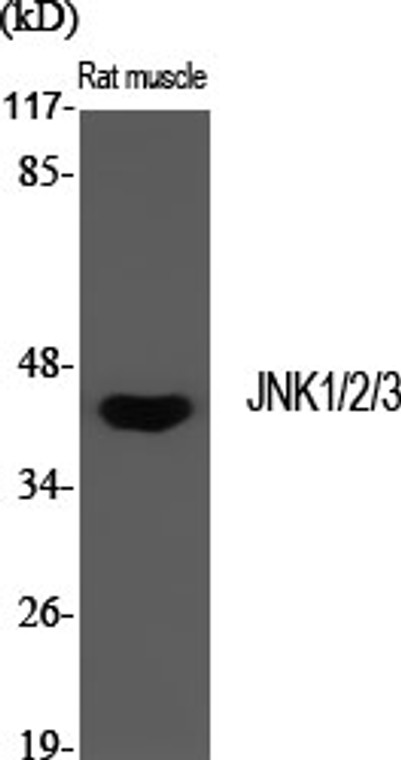| Host: |
Rabbit |
| Applications: |
WB/IHC/IF/ELISA |
| Reactivity: |
Human/Mouse/Rat/Chicken/Fish/Pig |
| Note: |
STRICTLY FOR FURTHER SCIENTIFIC RESEARCH USE ONLY (RUO). MUST NOT TO BE USED IN DIAGNOSTIC OR THERAPEUTIC APPLICATIONS. |
| Short Description: |
Rabbit polyclonal antibody anti-Mitogen-activated protein kinase 8 and Mitogen-activated protein kinase 9 and Mitogen-activated protein kinase 10 (166-215 aa) is suitable for use in Western Blot, Immunohistochemistry, Immunofluorescence and ELISA res |
| Clonality: |
Polyclonal |
| Conjugation: |
Unconjugated |
| Isotype: |
IgG |
| Formulation: |
Liquid in PBS containing 50% Glycerol, 0.5% BSA and 0.02% Sodium Azide. |
| Purification: |
The antibody was affinity-purified from rabbit antiserum by affinity-chromatography using epitope-specific immunogen. |
| Concentration: |
1 mg/mL |
| Dilution Range: |
WB 1:500-1:2000IHC 1:100-1:300IF 1:200-1:1000ELISA 1:10000 |
| Storage Instruction: |
Store at-20°C for up to 1 year from the date of receipt, and avoid repeat freeze-thaw cycles. |
| Gene Symbol: |
MAPK9MAPK10560156025599MK09_HUMANMK10_HUMANMK08_HUMAN
|
| Immunogen Region: |
166-215 aa |
| Specificity: |
JNK1/2/3 Polyclonal Antibody detects endogenous levels of JNK1/2/3 protein. |
| Immunogen: |
The antiserum was produced against synthesized peptide derived from the human SAPK/JNK at the amino acid range 166-215 |
| Function | Serine/threonine-protein kinase involved in various processes such as cell proliferation, differentiation, migration, transformation and programmed cell death. Extracellular stimuli such as proinflammatory cytokines or physical stress stimulate the stress-activated protein kinase/c-Jun N-terminal kinase (SAP/JNK) signaling pathway. In this cascade, two dual specificity kinases MAP2K4/MKK4 and MAP2K7/MKK7 phosphorylate and activate MAPK8/JNK1. In turn, MAPK8/JNK1 phosphorylates a number of transcription factors, primarily components of AP-1 such as JUN, JDP2 and ATF2 and thus regulates AP-1 transcriptional activity. Phosphorylates the replication licensing factor CDT1, inhibiting the interaction between CDT1 and the histone H4 acetylase HBO1 to replication origins. Loss of this interaction abrogates the acetylation required for replication initiation. Promotes stressed cell apoptosis by phosphorylating key regulatory factors including p53/TP53 and Yes-associates protein YAP1. In T-cells, MAPK8 and MAPK9 are required for polarized differentiation of T-helper cells into Th1 cells. Contributes to the survival of erythroid cells by phosphorylating the antagonist of cell death BAD upon EPO stimulation. Mediates starvation-induced BCL2 phosphorylation, BCL2 dissociation from BECN1, and thus activation of autophagy. Phosphorylates STMN2 and hence regulates microtubule dynamics, controlling neurite elongation in cortical neurons. In the developing brain, through its cytoplasmic activity on STMN2, negatively regulates the rate of exit from multipolar stage and of radial migration from the ventricular zone. Phosphorylates several other substrates including heat shock factor protein 4 (HSF4), the deacetylase SIRT1, ELK1, or the E3 ligase ITCH. Phosphorylates the CLOCK-ARNTL/BMAL1 heterodimer and plays a role in the regulation of the circadian clock. Phosphorylates the heat shock transcription factor HSF1, suppressing HSF1-induced transcriptional activity. Phosphorylates POU5F1, which results in the inhibition of POU5F1's transcriptional activity and enhances its proteosomal degradation. Phosphorylates JUND and this phosphorylation is inhibited in the presence of MEN1. In neurons, phosphorylates SYT4 which captures neuronal dense core vesicles at synapses. Phosphorylates EIF4ENIF1/4-ET in response to oxidative stress, promoting P-body assembly. JNK1 isoforms display different binding patterns: beta-1 preferentially binds to c-Jun, whereas alpha-1, alpha-2, and beta-2 have a similar low level of binding to both c-Jun or ATF2. However, there is no correlation between binding and phosphorylation, which is achieved at about the same efficiency by all isoforms. |
| Protein Name | Mitogen-Activated Protein Kinase 8Map Kinase 8Mapk 8Jnk-46Stress-Activated Protein Kinase 1cSapk1cStress-Activated Protein Kinase Jnk1C-Jun N-Terminal Kinase 1 |
| Database Links | Reactome: R-HSA-111446Reactome: R-HSA-139910Reactome: R-HSA-193648Reactome: R-HSA-205043Reactome: R-HSA-2559580Reactome: R-HSA-2871796Reactome: R-HSA-376172Reactome: R-HSA-450321Reactome: R-HSA-450341Reactome: R-HSA-5693565Reactome: R-HSA-9007892Reactome: R-HSA-9673324 |
| Cellular Localisation | CytoplasmNucleusCell JunctionSynapseIn The Cortical NeuronsPredominantly Cytoplasmic And Associated With The Golgi Apparatus And Endosomal FractionIncreased Neuronal Activity Increases Phosphorylated Form At SynapsesColocalizes With Pou5f1 In The Nucleus |
| Alternative Antibody Names | Anti-Mitogen-Activated Protein Kinase 8 antibodyAnti-Map Kinase 8 antibodyAnti-Mapk 8 antibodyAnti-Jnk-46 antibodyAnti-Stress-Activated Protein Kinase 1c antibodyAnti-Sapk1c antibodyAnti-Stress-Activated Protein Kinase Jnk1 antibodyAnti-C-Jun N-Terminal Kinase 1 antibodyAnti-MAPK8 antibodyAnti-JNK1 antibodyAnti-PRKM8 antibodyAnti-SAPK1 antibodyAnti-SAPK1C antibody |
Information sourced from Uniprot.org
12 months for antibodies. 6 months for ELISA Kits. Please see website T&Cs for further guidance











